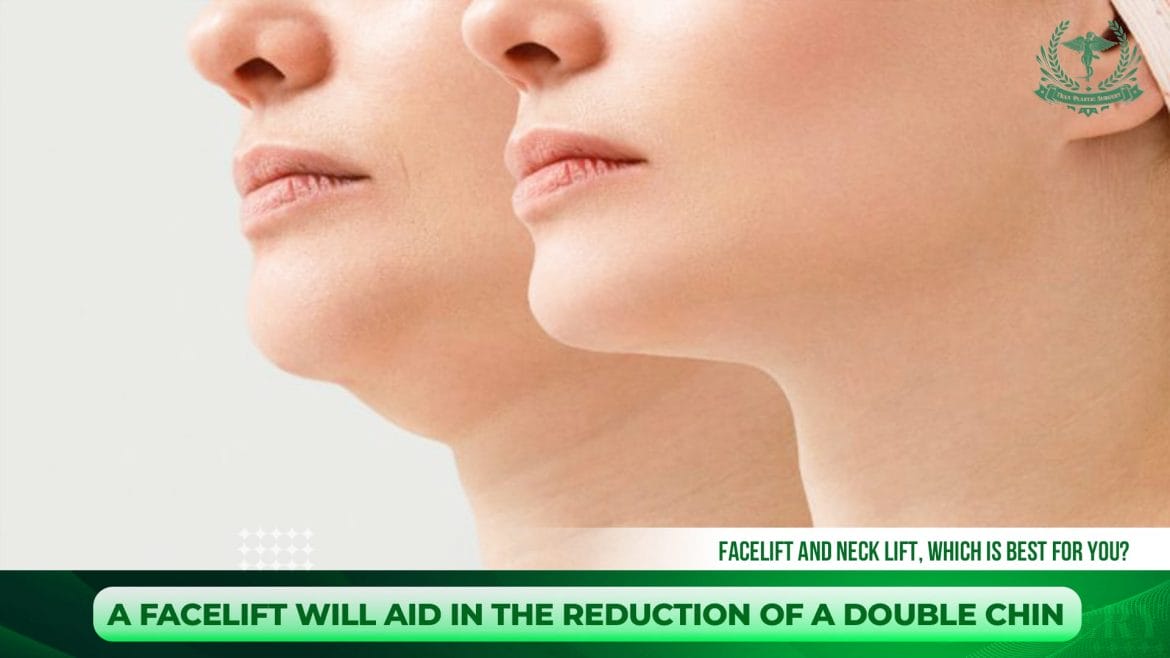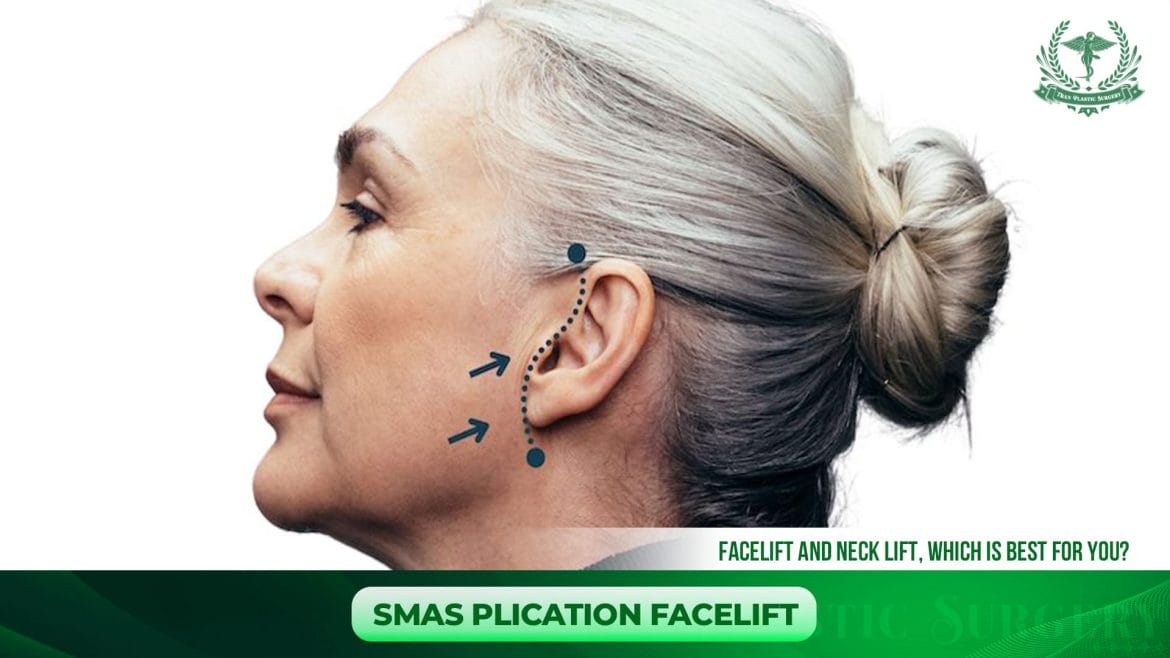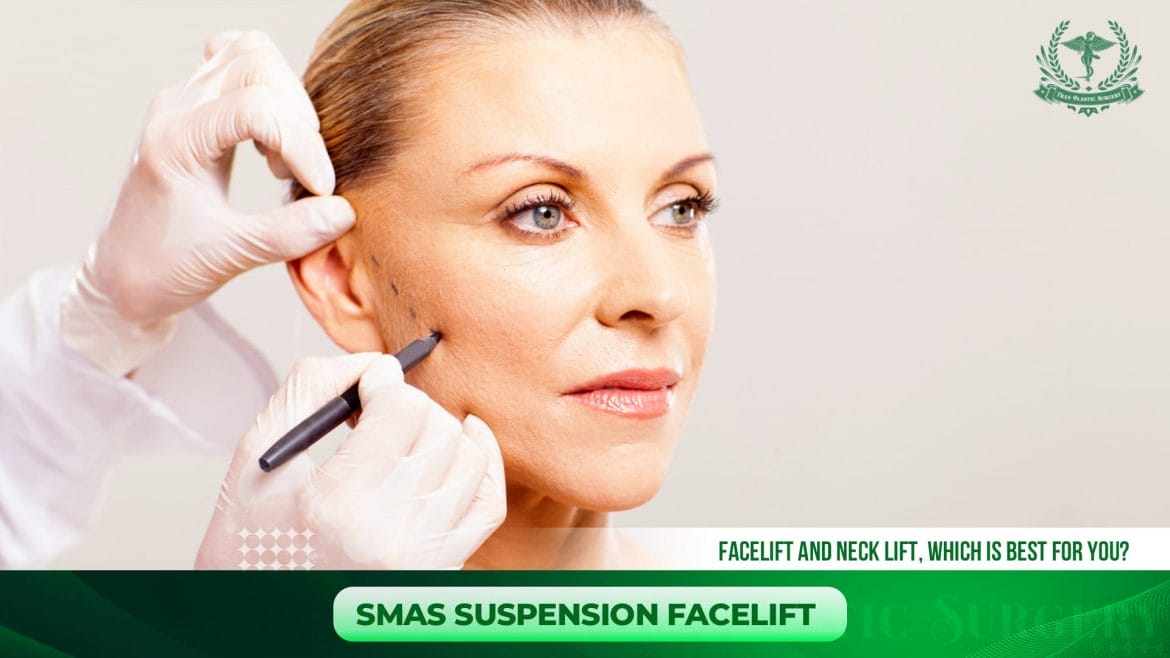There are numerous factors that contribute to skin aging and sagging. Therefore, in order to achieve facial and neck skin tightening, cosmetic surgical intervention is often required. Facelift surgery involves the removal of excess skin, tightening of the underlying tissues and muscles, and repositioning the skin on the face and neck. Facelift surgery can address midface sagging, deep nasolabial folds, sagging along the jawline, and a double chin while preserving essential facial features that serve as “golden standards” for facial rejuvenation.
Approaches to Facelift and Neck Lift

Facelift and Neck Lift can be performed in different ways. Modern facelifts typically involve lifting and tightening the deep layers of the face, removing any excess skin from the neck and face, and then redraping the skin. In this method, a scar is inserted into the hair behind the ear, along the hairline, and along the front and rear of the ear.
Our face lifting procedure is tailored to the specific requirements of each patient. The extent of face aging that the patient exhibits is carefully evaluated, and the operation is planned to address those particular issues. A more restricted approach to the face and neck lift can be pursued in cases with minor facial aging. A more extreme strategy that involves lifting and redraping the majority of the skin on the lower face and neck may be required in more severe situations. To get rid of the additional fatty deposits in the neck along the jawline and beneath the chin, liposuction is frequently combined with a face and neck lift.
Causes of sagging skin

Stretching and snapping back into position are simple with firm skin. Skin begins to droop when it lacks this capacity. On the body, sagging skin can occur practically anywhere. Sagging skin can occur in: :
- Eyelids
- Jowls
- Chin
- Throat
- Higher arms
- Stomach
Saggy skin can result from a number of factors namely:
Aging
Elastin and collagen, two crucial proteins produced in the dermis, are lost by the skin as it ages.
Elastin gives skin elasticity, as its name implies. It offers elastic skin that can bounce back after being stretched.
Fibroblasts create collagen. Collagen is responsible for the taut and firm appearance of skin. Collagen is made up of densely packed fibers that support the stability and rigidity of the skin.
As people age, their ability to produce elastin and collagen decreases. Additionally, with time, these two proteins may degrade due to outside influences such as:
- UV exposition
- Environmental toxins, such as cigarette smoke
- Certain lifestyle habits, such as eating poorly and consuming excessive amounts of alcohol
Inadequate skin care and excessive sun exposure can hasten the aging process of your skin. Your skin may appear sagging and wrinkled earlier than it would otherwise.
Weight loss
The collagen and elastin fibers in your skin can become damaged over time if you carry extra weight. As a result, it is more difficult for skin to recover after weight loss. Significant quantities of sagging skin may develop if you lose 100 pounds or more of body weight.
Rapid weight loss, such as that which follows bariatric surgery, increases the likelihood of sagging skin. These weight loss techniques could occasionally leave the body with a significant amount of sagging, drooping skin.
Your age at the time of weight reduction might also affect how sagging your skin appears because younger skin recovers more quickly.
Pregnancy
It’s typical for women to develop some saggy, loose skin after giving birth. Women who have multiples, like twins or triplets, may experience more abdominal skin drooping than those who only carry one child. Age of the mother may also be important.
Illness
Saggy skin is an indication of a few medical disorders. One of these is granulomatous slack skin, a highly uncommon variant of cutaneous T-cell lymphoma.
Skin on the knees and elbows begins to sag quite often in people with this illness. Granulomatous slack skin can produce sagging skin which is difficult to treat.
Ehlers-Danlos disease
Ehlers-Danlos syndrome (EDS), a rare, inherited connective tissue illness, is another ailment that results in droopy skin. A deficiency in the creation of collagen causes droopy, doughy skin, frequently on the face, in people with EDS.
Facelift and Neck Lift Benefits
Advantages of Neck Lift

A young, slim neck should be firm and taut with no double chin, sagging skin, or muscular banding. Your neck may get considerable amounts of slack skin, deep wrinkles, and extra fat deposits as the aging process progresses. Vertical muscular bands could occur as the tissues weaken with aging.
When the face receives so much attention, it’s quite simple to overlook your neck, yet your neck can also give away your age. Some of the major advantages of this surgery are listed below:
It slows down the aging process
Patients in their early to mid-30s frequently choose a neck lift over other types of cosmetic surgery. This occurs frequently because the area frequently ages more quickly than your face due to specific lifestyle variables and habits. For instance, people who spend a lot of time in the sun frequently neglect to apply sunblock to their necks, exposing their skin to the full force of the sun’s rays and causing their neck skin to age more quickly than other parts of their body.
Having cosmetic neck surgery earlier in life helps slow down the passage of time. Soon after surgery, you’ll see changes in your looks, and you’ll continue to enjoy the advantages of a more youthful-looking neck as you get older. Although aging will still occur as a result of the procedure’s effects, you’ll seem to be younger than you would have otherwise.
The outcomes may be striking
Every patient that visits has certain cosmetic objectives they would like to accomplish. While some patients have very straightforward objectives, others seek spectacular outcomes from cosmetic surgery.
For instance, surgery can address all of your concerns if they relate to a double chin, “turkey wattle,” or thick bands of muscle that run up and down your neck. Your operation can be paired with liposuction to remove extra, unwanted fat from the area, giving you a leaner, younger-looking appearance if you have excessive fatty tissue in the area of your neck and chin.
As part of the operation, the skin is also tightened to address laxity and wrinkles. This tightens the area and eliminates the skin pocket (and occasionally fat) under your chin. You might be able to erase a decade or more from the appearance of your neck, depending on your goals and your current health.
Later on, you’ll require fewer procedures
By choosing to have the treatment done early in life, you’ll wind up saving money and time by avoiding the need for more involved procedures later on. A partial facelift in your 50s may not be necessary if you had the operation done in your 30s or even early 40s. If you decide to have another treatment later in life, you might just require a micro or mid-facelift rather than a full facelift.
Short recovery time
This lift can be seen as intrusive because it involves surgery and will need recovery time. You’ll be relieved to learn that your healing period isn’t that long if you have an active, busy life. Following a week, most patients are able to go back to work, and three weeks following their surgery, they can resume their normal daily activities.
It may be combined with different procedures
The technique can be supplemented with additional facial rejuvenation procedures if the results you want go beyond what this one can provide. Combining operations might assist you in achieving your aesthetic objectives and give you a more balanced, young appearance. In order to treat loose skin, wrinkles, and fat deposits all over their face and neck, patients frequently get a neck lift and facelift done simultaneously.
Advantages of Facelift

You’re likely to encounter someone who had a facelift on TV. Some of them looked noticeably different after the treatment than they did before. It makes sense that a lot of individuals are worried about how a facelift can alter their appearance. Although it is true that a facelift may (and most certainly will) change your appearance in some way, these advantages are often incredible.
Facelifts Address Several Aging Signs at Once
The face’s look and the skin’s texture change in a variety of ways as we age naturally. Smoking, stress, and sun exposure can all have negative effects on the skin in addition to advancing age. Facelifts can help you look younger by focusing on different aging symptoms, giving your face and neck a tighter appearance. A facelift can treat multiple aesthetic problems at once, including drooping skin, deep wrinkles and creases between the nose and mouth, wrinkles that run from the lips to the chin, a double chin, and problems with extra fat.
A facelift will aid in the reduction of a double chin

A facelift may help to minimize or even get rid of the extra skin or fat that has developed around your neck if you are unhappy with its appearance. Age-related skin sagging and wrinkles around the neck are a common occurrence. Unfortunately, depending on how much of your skin is wrinkled or folded, you may look much older than you actually are, which can be embarrassing or uncomfortable when you wear apparel that exposes your neck. By tightening and removing extra skin, a facelift and neck lift can assist in addressing these issues.
A facelift can eliminate jowls
Excess skin around the face and chin can be caused by aging, exposure to the sun, and even major weight reduction. A facelift might result in a narrower, thinner jawline for those who want to “fix” their unattractive jowls. A facelift can tighten up sagging areas and restore a youthful appearance to your jawline by recontouring the jaw and upper neck regions.
Constrict sagging facial skin
Collagen levels and reserves in the body decline due to aging. As a result, loose or sagging skin begins to appear. The effects of a lifetime of sun exposure and the loss of collagen cannot be stopped by over-the-counter or prescription treatments, but there comes a point where they lose their effectiveness. A facelift will decrease sagging and restore a smooth, young aspect to the face by removing extra skin and tightening the neck and facial muscles.
Deep Wrinkles Can Be Reduced with Facelift

A decrease in collagen production might also result in deep wrinkles. Deep wrinkles, particularly those that develop between the mouth and nose (also known as smile lines) and those that develop between the mouth and chin (also known as marionette lines), can be lessened with a facelift (and related operations like dermal fillers).
Not Only Women Can Get Facelift
Men experience age-related skin difficulties as well, despite the fact that aging and women’s skin issues receive a lot of attention. According to data from the American Society of Aesthetic Plastic Surgery, facelifts were among the ten most popular treatments for males in 2019. Male patients with jowls, drooping skin, misplaced fat, and unattractive facial wrinkles might also benefit from facelift operations.
There is no ideal age for facelift
Contrary to popular assumption, a person can be a good candidate for a facelift treatment at any stage of life. Anyone with drooping skin or unsightly wrinkles can have a facelift, even though patients who undergo the operation most frequently are between the ages of 50 and 65. With a variety of options, your highly skilled surgeon can customize your surgery to achieve your goals in the least intrusive way possible.
Facelift Operations Go Well with Other Cosmetic Operations

There are numerous cosmetic surgeries available to change and resolve unfavorable skin and facial issues. Fortunately, many of these operations can be carried out simultaneously with a facelift to avoid the need for separate or additional surgeries. For instance, some patients may decide to undergo brow or eyelid surgery concurrently with a facelift. This cuts down on the amount of additional recuperation time required and helps guarantee uniform results all over your face.
Vanishing surgical scars
The facelift surgery involves making undetectable incisions. This is done to make sure there are no telltale traces that a cosmetic operation has ever been carried out. Although each patient’s specific therapy determines the size and position of their incisions, most incisions are placed behind the ear or along the hairline to facilitate concealment.
Natural look:
Although it is difficult to “naturally” go back in time, a facelift operation can help you look younger. In the past, facelifts caused excessive skin tightening or an appearance that said “work” had been done. To restore a more youthful appearance and natural-looking contours without a “windblown” appearance, modern facelift treatments skillfully tighten the skin. You will still look like you after a facelift, but younger!
Approaches to Facelift and Neck Lift at Tran Plastics Surgery
Mini Facelift

A mini facelift is a slightly modified version of a traditional facelift. Both are invasive cosmetic procedures that involve the use of incisions to help remove and pull up sagging skin.
You may be a candidate for a mini version if you’re looking to achieve these goals with fewer incisions and you have less excess skin to remove.
Despite its name, a mini facelift is still a major cosmetic procedure. It’s important to weigh all the benefits versus the costs and risks before undergoing any type of cosmetic surgery.
SMAS Plication Facelift

The most common type of surgical facelift, an SMAS plication facelift works on a shallower layer of tissues than the deep plane facelift. The SMAS is the superficial musculoaponeurotic system below the skin in your mid-to-lower face. “Plication” is the term for a surgical tightening of tissues, which usually involves lifting, removing excess, and rejoining remaining tissues. In a SMAS plication facelift, the SMAS layer is lifted vertically and re-anchored in front of the ears to create a lift of about 1 cm. Some surgeons may also lift from further down into the cheek, at the front of the earlobe, for expanded effects. Still, even an expanded SMAS facelift procedure cannot compare with the more comprehensive improvements offered by a deep plane facelift.
Deep Plane Facelift

A deep plane facelift is a facial surgery where the SMAS, a layer of connective tissue underneath the facial skin, is lifted to tighten the cheekbones, jawline, and neck.
A deep plane facelift achieves tighter skin, defines the facial features, and reduces elasticity in the neck. Out of the different types of facelifts, the deep plane facelift is the most effective – yielding results that make patients look 12-15 years younger.
It also restores the cheek area back to its original position and improves the hollowness in the lower eyelid.
SMAS Suspension Facelift

Facelift SMAS suspension is a surgical procedure that tightens sagging facial tissues to eliminate the jowls, clean up the neck, and highlight the new facial contours. The MACS lift is a type of facelift that uses a vertical and oblique purse-string suture to plicate the SMAS and lift it towards its suspension point on the deep temporalis fascia just above the posterior zygomatic arch. Scars are hidden within the hairline, behind the tragus of the ear, and in the post-auricular groove.
What are the steps to have a facelift done?
The following steps are included in a facelift procedure:
Step #1: Anesthesia
During the surgical procedure, you will receive medication for comfort. Both general anesthesia and intravenous sedation are available options. Your doctor will offer the best option for you. The results of a facelift can be further improved by a number of additional procedures. They consist of:
- Using fat transfer or facial implants to improve contour
- Utilizing resurfacing methods to enhance the texture and tone of face skin
- Using fillers or fat injections to reduce wrinkles
Step #2: Making the cut
Your facelift options include a regular facelift, a restricted incision facelift, or a neck lift, depending on how much change you’d like to see.
An incision for a classic facelift frequently starts in the hairline near the temples, travels around the ear, and terminates in the lower scalp. In addition to repositioning underlying tissue and sculpting or redistributing fat from the face, jowls, and neck, it is also frequently necessary to lift the muscles and deeper layers of the skin on the face. Excess skin is removed and redraped over the raised features.
To further rejuvenate an aged neck, it could be required to make a second incision under the chin. The incisions are closed using sutures or skin adhesives.
Step #3: Closing the incisions
Sutures used to close the wounds may disintegrate or need to be removed after a few days. To close the incisions, some surgeons employ skin glues. After healing, the facelift’s incision lines blend in seamlessly with the hairline and the ear’s natural contours.
Step #4: Examine the outcomes
Once the bruises and swelling have subsided, the visible results of a facelift become apparent. The end result ought to give you back a more rested and young appearance as well as boost your self-esteem.
How to take care of your incisions after a Facelift and Neck Lift

- Using hydrogen peroxide-soaked cotton swabs, clean your incisions. Apply the cotton swab gently three times each day over your suture lines. Your ears will have suture lines in front of and behind them. The hydrogen peroxide should then be carefully dried with a dry cotton swab. To keep the incision sites wet, use a small amount of Bacitracin ointment using the cotton swab.
- Crusting: The area around the sutures may occasionally develop a crust. Don’t try to take this out on your own. This is typical and will get better. Daily showering will reduce crusting.
- Avoid being outside in the sun as much as you can. This will accelerate the healing of scars and reduce swelling. When outdoors during the first year, it is necessary to apply an SPF of 30 or higher. Even a minor sunburn has the potential to permanently discolor skin, exacerbate edema, and irritate a wound that is still healing.
- Avoid attempting to remove stitches or staples on your own. At your follow-up appointments, your surgeon will remove any staples and permanent sutures.
- Makeup: For the first four days, refrain from wearing makeup. For at least a week after starting to use makeup, stay away from applying it directly to healing incisions.
Maintaining Youthfulness for up to 10 Years with SMAS Face Lift
Surgery called the SMAS facelift (rhytidectomy) is used to improve the shape of the neck and the lower two-thirds of the face. This facelift eliminates jowls, double chins, sagging skin, extra fat, and other aging-related flaws. The recovery or recuperation period is shorter and less invasive than with a traditional facelift.
The layer that joins the face and neck muscles to the skin is known as the SMAS (superficial muscular aponeurotic system). It contributes significantly to facial expression and is made up of fibers, collagen, and connective tissue.
The SMAS facelift is covered in this article along with who is a good candidate, potential hazards, and the steps involved.
Difference between Deep Plane Facelift and High SMAS Facelift

- Procedure: A Deep Plane Facelift raises all the muscles and skin layers in a single flap, unlike a High SMAS. In that it releases the facial ligaments and goes deep into the muscle, it is comparable to a High SMAS.
- Results Both facelift methods are excellent. The lower eyelid, cheek, nasolabial folds, midface, jowls, and neck will all be lifted by a high SMAS facelift. While Deep Plane Facelift tightens the face for a renewed appearance, it also helps to correct lower eyelid hollowing, deep facial wrinkles, and jowls.
- Recovery: Both operations can render you socially inactive for two weeks. Patients who have a high SMAS facelift might anticipate less bruising because the operation causes less damage to the skin’s superficial layers than other facelift methods.
- Because the Deep Plane Facelift raises the skin and muscle layers in one composite flap with little bruising and swelling, patients recover more quickly than with conventional facelift methods.
- Ideal Candidates: High SMAS is best paired with Neck Lift for more dramatic effects. It is best for individuals who wish to treat lower eyelid hollowing, deep nasolabial folds, jowls, and neck laxity or a double chin.
Any age group can benefit from deep plane facelifts, but individuals under 55 who want to smooth marionette lines, lift their cheeks, and lift their jowls in particular might consider them when a neck lift is not necessary.

If you’re looking for a clinic that specializes in internationally recognized SMAS facelifts, be sure to visit Tran Plastics Surgery. We will have Dr. Tuan provide you with personalized guidance to make the right decision for a youthful and confident appearance.
Through this article, Tran Plastics Surgery has provided you with detailed information about the benefits of facelift procedures for maintaining a youthful appearance. We hope you now understand the advantages of facelift surgery, and we encourage you to carefully consider your health status and consult with a physician before undergoing any surgical procedures. Tran Plastics Surgery appreciates your attention and support.

